Traditional Braces
A Surefire Way to Straighten Your Smile
Many patients these days are opting to straighten and enhance their smiles with the assistance of orthodontics. And while clear aligner treatments like Invisalign have certainly skyrocketed in popularity, traditional braces in Lake Nona still remain an effective and reliable alternative! Keep reading to learn a little more about how traditional braces work or feel free to give us a call for additional information or to schedule a visit.
Why Choose Lake Nona Dental Group for Traditional Braces?
- Friendly and Experienced Dental Team
- Digital Imaging System for Comfortable Impressions
- Results You’ll Be Proud to Show Off
How Do Traditional Braces Work?
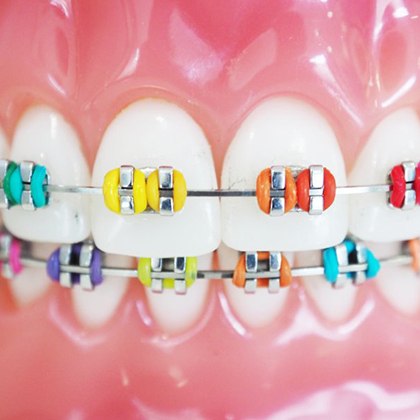
Your teeth aren’t totally immobile; they’re attached to the jawbone via tiny ligaments that allow them to have a natural capacity for movement. Traditional braces encourage your teeth to shift positions inside your mouth. By applying gentle, sustained pressure with the use of metal brackets and wires, braces can gradually move your teeth into a more-aligned position. This process often takes over 12 months to complete depending on your orthodontic needs, and if necessary, additional accessories and attachments including elastics and retainers are also used to assist with movement.
What Orthodontic Issues Can Braces Fix?

When you visit us, we’ll be able to determine exactly how traditional braces can benefit your smile! They can be used to correct a variety of common orthodontic issues, including:
Bite Misalignment
Whether you suffer from an overbite, underbite, or crossbite, braces can help! These types of misalignments can often lead to serious problems including TMJ disorder and bruxism (teeth grinding). However, braces can easily correct your bite and in turn, improve your chewing and speech patterns.
Crowded & Crooked Teeth
In some cases, your teeth might not have an adequate amount of room inside your mouth, leading to them becoming crooked and overlapping. Needless to say, this can take a toll on your self-esteem, but it also vastly increases your chances of developing cavities! Traditional braces can ensure that every one of your teeth has plenty of breathing room.
Gapped Teeth
Small spaces between your teeth can be frustrating! Not only do they impact your smile’s beauty, but they can also easily trap excess food debris and increase your risk of oral health issues. But as the brackets and wires exert precise pressure, they close those gaps and correct visual and functionality issues alike.
Caring For Your Braces

Your braces can only do their job if you take great care of them! You’ll want to keep them clean and intact to the best of your ability, since a broken wire or loose bracket will only delay your overall treatment timeline. Consider the following when caring for your smile with braces:
- Follow your dietary guidelines and restrictions, and avoid problematic foods that are particularly hard, crunchy, or chewy.
- Practice sports safety by wearing a mouthguard during sports and physical activity.
- Brush your teeth for two full minutes after every meal, and don’t skip flossing; dental flossers can make flossing with braces much easier!
- Prioritize your adjustment appointments; this also allows us to inspect the integrity of your braces to make sure that nothing’s off.
Understanding the Cost of Traditional Braces
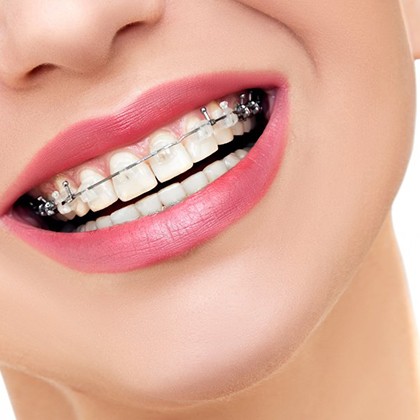
If you’re unhappy with the state of your smile due to crooked or misaligned teeth and you’re ready to do something about it, our team here at Lake Nona Dental Group is ready to step in and assist you every step of the way—including understanding the cost of treatment! We’ll be happy to provide you with an estimate when you visit us for a consultation, so don’t hesitate to give us a call for more information or if you have any questions.
Factors That Affect the Cost of Traditional Braces
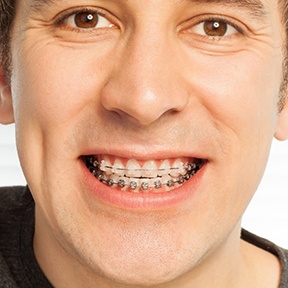
There are several factors that can affect the cost of braces, such as:
- The severity of your misalignment: This is the most significant contributing factor to the overall price of braces, and it affects treatment length, what type of accessories you will need, and more.
- Age: Adults’ teeth tend to move more slowly than those of teenagers, which can make treatment complex and slightly more costly.
- The number of appointments needed: Braces must be adjusted periodically throughout the treatment. The frequency of these appointments can influence the total cost of your care.
- Compliance with treatment guidelines: Failing to wear your elastics, or eating food that damages your braces, can delay your treatment and incur extra expenses.
Professional Braces vs. “DIY” Braces: Which Costs More?

Maybe you’ve seen reports on social media about people who have created their own “braces” using household objects such as fishing line, Super Glue, paperclips, and more. These DIY solutions may seem appealing and more affordable, but properly realigning your teeth is a complex process. Without training or professional supervision, you could inadvertently cause serious, irreversible damage to your smile, requiring even more expensive treatment to fix later on! In the end, it’s safer and less expensive to do it right the first time with professional assistance.
Does Dental Insurance Cover Braces?
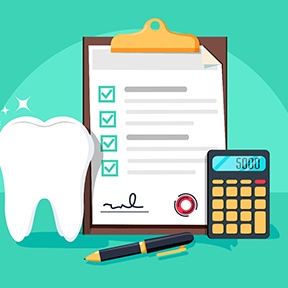
If you are fortunate enough to have dental insurance, the good news is that most policies include partial coverage for traditional braces! This means you could spend less money out-of-pocket than you would without insurance. When you come in for your initial consultation, our team can take a look at your plan to confirm coverage and let you know how much you will be expected to pay after insurance has been billed; we’ll be sure to help you save wherever you can!
Options for Making Braces Affordable

We’re more than happy to work with you to find a way to make your treatment more affordable! If you don’t have dental insurance or orthodontic coverage, we offer third-party financing options including CareCredit and LendingClub. If you’re ready to straighten your smile, don’t hesitate to schedule a consultation to figure out the specifics!
Traditional Braces FAQs
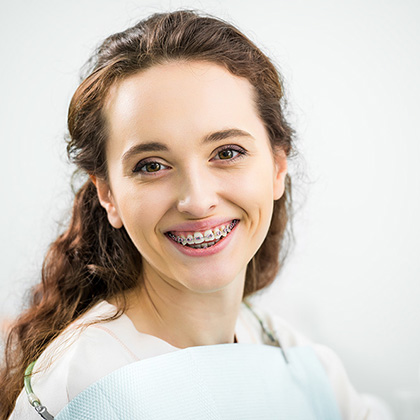
You might understandably have some questions about traditional braces you’d like answered before you’re ready to commit to the treatment. Our team here at Lake Nona Dental Group has gathered some of the most frequently asked questions and answers about traditional braces so that you can confidently go into the process. If you have any other questions or concerns about braces, feel free to give us a call for further information or to schedule a consultation.
Do Traditional Braces Hurt?
Many patients have reasonable concerns about pain when it comes to dental work, but you don’t need to fear traditional braces. You may feel mild soreness in your teeth and gums for the first few days after getting your braces, but the good news is it’s only temporary and should dissipate. You can manage your discomfort in the meantime by taking over-the-counter pain medication and eating softer foods. Throughout your treatment, you may experience some discomfort as your teeth are shifting into new positions. If needed, you can use orthodontic wax to protect your soft oral tissues and avoid irritation.
What Can You Not Eat with Traditional Braces?
Unfortunately, there are some foods out there that can wreak havoc on your braces if you aren’t careful! In general, you should try to stay away from items that are particularly hard, chewy, or sticky, including:
- Popcorn and nuts
- Corn on the cob
- Starchy items like chips
- Sticky, chewy, or hard candy such as caramel, taffy, lollipops, and jawbreakers
- Tough breads, cookies, crackers, taco shells, pretzels, etc.
It’s also worth mentioning that you should also avoid chewing on hard non-food objects as well, as they can be just as problematic! Don’t gnaw on things like ice cubes, pen caps, or your fingernails.
Can I Chew Gum with Traditional Braces?
Chewing gum with braces is discouraged because it can easily get stuck, causing your wires to potentially bend or your teeth to shift in unexpected directions. However, some studies show that chewing gum can actually relieve pain from orthodontic treatment and reduce gum inflammation. It’s also been proven to lower the risk of decay if chewed for 20 minutes after eating a meal or snack. But ultimately, these so-called benefits are usually not worth the risk of harming your braces and jeopardizing your treatment time!
What Happens After I Get My Braces Taken Off?
Once your braces are removed, you’re not out of the woods yet; there is usually still a little more work to be done! You’ll be given a custom retainer to wear in order to ensure that your teeth remain in their new positions. We’ll monitor your progress moving forward and provide you with detailed instructions regarding how often to wear your retainer—but this wear time will become less frequent as time passes, assuming you’re diligent.


